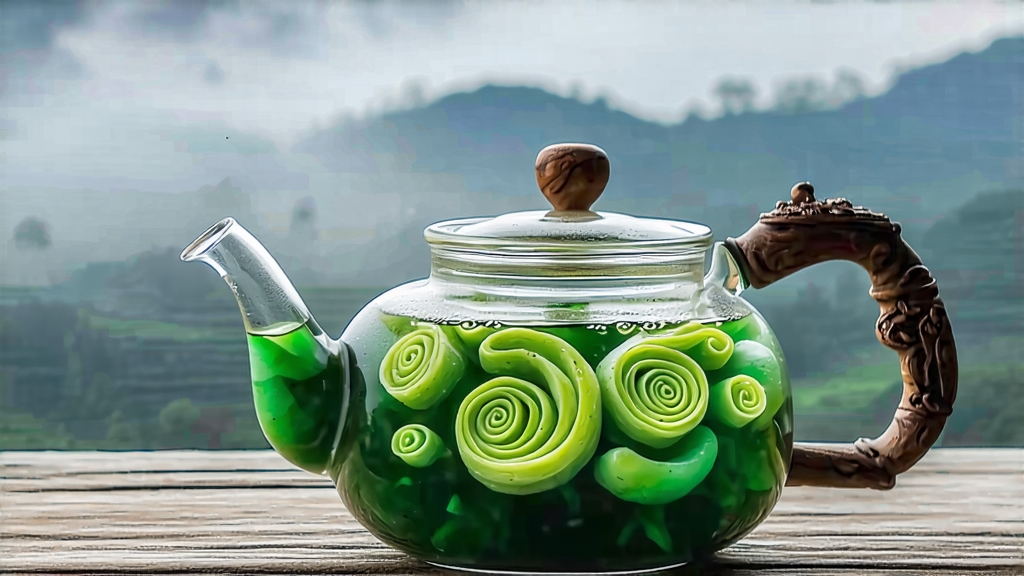
Among the countless shades of green that paint China’s tea hills each spring, few leaves are as instantly recognizable—or as romantically named—as Biluochun. Literally “Green Snail Spring,” the tea’s tiny, spiral-shaped pellets look like miniature jade shells plucked from the shores of Lake Tai. Yet behind the whimsical name lies a pedigree that once delighted Qing-dynasty emperors, a fragrance so intense that locals claim it can scent an entire room before the water even boils, and a crafting technique so exacting that a single kilo demands sixty to eighty thousand buds. For the international drinker seeking the freshest, most delicate face of Chinese green tea, Biluochun offers both a sensory revelation and a window into the horticultural poetry of the lower Yangtze basin.
Historical roots
The earliest written record appears in 1699, when the Kangxi Emperor visited Lake Tai’s Dongting Dongshan peninsula and was presented with a local tea so fragrant that court annalists dubbed it “Scary Fragrance” (Xia Sha Ren Xiang). Legend attributes the perfume to an afternoon breeze carrying the scent of flowering orange and peach trees into the tea garden. Whether apocryphal or not, the story illustrates a key ecological fact: Biluochun grows in an intensively inter-cropped system where tea bushes share terraces with plum, apricot, loquat and citrus, allowing the leaf to absorb floral volatiles long before it ever meets hot water. Kangxi, charmed, rechristened the tea Biluochun for its snail-like roll and spring harvest, elevating it to tribute status. From that moment onward, every spring caravan leaving Suzhou for the northern capital carried sealed bamboo canisters lined with pomelo peel to keep the precious curls fragrant.
Terroir and cultivar
True Biluochun comes only from the Dongting Dongshan and Xishan islands in Lake Tai, Jiangsu Province. The lake’s microclimate—morning mist, moderate temperature oscillation, and sandy, slightly acidic alluvial soil—forces the tea plant to synthesize more amino acids and aromatic esters than inland counterparts. Growers rely primarily on the small-leaf “Fuding Da Bai” clone for its downy buds, but old-garden “Dongshan Qunti” seed-grown bushes are prized for deeper, more complex aromatics. After decades of clonal expansion, the region now recognizes five sub-grades based on elevation, age of bush, and proximity to fruit trees: Supreme Fruit-Adjacent, Top Lake-View, Standard Lake-View, Lower Slope, and Valley Floor. International buyers will most often encounter the first two, harvested between the Qingming festival (early April) and Grain Rain (late April), when each bud still wears its silvery down and measures under 2.5 cm.
Pluck standard
The picking code is ruthless: one bud with the just-opening first leaf, no longer than 2 cm, harvested at dawn while the morning dew is still intact. Experienced pickers finish their baskets before 9 a.m. to prevent noon-day oxidation. A single mu (one fifteenth of a hectare) yields barely four kilograms of fresh leaf, which after firing becomes one kilo of finished tea. Such selectivity explains why authentic Biluochun often costs more than silver by weight.
Crafting the spiral
Within four hours of plucking, the leaf enters a six-step dance of heat, pressure and timing unique among Chinese greens.
- Withering on bamboo trays for 30–45 minutes evaporates surface moisture and softens cell walls, preparing the leaf for shaping without breakage.
- Pan-firing at 180 °C for three minutes kills green enzymes in a wok barely wider than a dinner plate. The master’s wrist motion—scoop, toss, press—must be swift enough to halt oxidation yet gentle enough to preserve the down.
- Rolling & spiraling while the leaf is still 60 °C hot is the signature step. Using only the heel of the palm, the crafter rubs small batches along the wok’s rim in clockwise circles, coaxing the bud to curl into a tight spiral. The motion resembles kneading dumpling dough, except the ingredient is 200 fragile buds that can turn to powder with one extra second of pressure.
- First drying at 120 °C reduces moisture to 30 % and locks in the curl.
- Re-firing at 80 °C for 40 minutes develops the